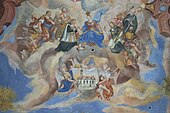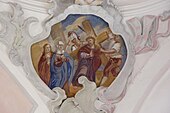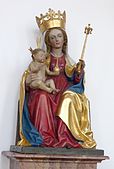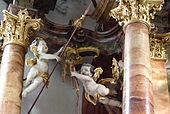Virgin Mary's Pain (Waldkirch)
The Catholic parish and pilgrimage church of Mary Pain in Waldkirch , a district of Winterbach in the district of Günzburg in the Bavarian administrative district of Swabia , was built in 1745 by Joseph Dossenberger . Stucco and frescoes have been preserved from this period . The miraculous image , a Pietà , is dated around 1510. The church is a protected architectural monument .
history
The settlement and church ( Welschenkirche ) are mentioned for the first time in documents from around 1300 . However, nothing is known about the origin of the pilgrimage. In the local chronicle, foundations to Our Lady von Waldkirch are noted several times from the 14th century . After the Thirty Years War , the old church was demolished and replaced by a new building in 1668/69. Between 1695 and 1697, the church received its interior fittings from carpenters, sculptors and painters from Lauingen . The pilgrimage was probably revived from the end of the 17th century. As can be seen in Pastor Johann Ulrich Rimmele's book of miracles from 1749, the pilgrims came mainly from the Holzwinkel, the area between Zusam , Mindel and Donau . Mothers, in particular, wanted help for their sick children. As thanks for healings, the church received large amounts of money and donations in kind, which made the magnificent new building of the pilgrimage church possible in 1745.
At the end of the 18th century, in the Age of Enlightenment and in connection with Josephinism , the reforms of Emperor Joseph II , which also affected the Waldkirch, located in the Habsburg margraviate of Burgau , the pilgrimage declined.
architecture
Exterior construction
The tower covered with an onion dome rises on the north side of the nave . A two-storey, octagonal structure sits on its square substructure, reinforced with corner pilasters and broken up by arched sound arcades . The windows of the nave and choir are framed on the outer walls with a decor of painted pilasters and shell work . The entrances to the church are on the north and south sides.
Exterior facade with Rocailles decor
inner space
The nave is single-nave , divided into four axes and covered by a flat ceiling over a valley. The retracted choir is semicircular on the inside and closed on three sides on the outside. The walls of the choir and nave are divided into double pilasters and large windows with curved arches. The western end of the nave is formed by a double gallery with curved parapets that rests on square wooden pillars . The organ is located on the upper gallery .
Piece
The stucco decoration comes from the time the church was built and was executed by the builder Joseph Dossenberger himself.
Ceiling pictures
The ceiling frescoes were created by Anton Enderle (1700–1761) from Günzburg . The central theme of the ceiling fresco of the choir is the Sorrowful Mother , at whose feet petitioners and letters of mercy held in their hands as a token of their acceptance. The frescoes in the cartouches depict the Seven Sorrows of Mary (circumcision of Jesus, flight to Egypt, the twelve-year-old Jesus in the temple, carrying the cross, crucifixion, descent from the cross, burial). On the left edge of the fresco there is the inscription: Anno 1745 Funditus AEdificata est Ecclesia BV Alariae Sub me JUR (In 1745 this church was founded under the protection of the Blessed Virgin and built under me, Johann Ulrich Rimmele).
On the fresco of the nave, under the Holy Trinity, Mary is enthroned as Queen of Heaven, who offers his tongue to Johannes Nepomuk as a sign of his keeping the secret of confession. To the right of it, St. Roch , St. Leonhard and St. Wendelin float . On the left, St. Philip Neri , the founder of the Oratorians, receives a ring from Mary as a symbol of her mystical marriage. Next to it are the Saints Sebastian , Antonius and Isidore . In the lower half of the picture, angels hold a picture of the Church of Our Lady of Sorrows.
At the outer edge of the picture are shown the four continents that all venerate Mary. They alternate with scenes from the life of Mary (the birth of the Virgin, the Annunciation, the Visitation of Mary, the Purification of the Virgin ). The ceiling fresco bears the signature Ant: Enderle Pinxit 1745 .
Above the organ gallery, Mary is depicted crushing a snake's head after the Secret Revelation . On their left are Saints Ulrich , Ignatius von Loyola and Aloisius von Gonzaga , on their right are Saints Afra , Franz Xaver and Stanislaus Kostka . The depiction of Ignatius von Loyola and Franz Xaver, the founders of the Jesuit order , is a reference to the Bartholomäer Institute , a convent-like, Jesuit-oriented community of world priests, which was founded by Bartholomäus Holzhauser (1613-1658). In Waldkirch there was a branch of the Dillinger Bartholomäer Institute, which looked after the pilgrimage.
The smaller frescoes in the cartridges on the pilaster capitals are reminiscent of saints who were revered by the Bartholomäern: the holy Tosso , in the 8th century bishop of Augsburg , the missionary Gisilarius, the martyr Aquilinus , the holy Florinus , St. Ivo , the patron saint of lawyers, and Saint Valentin of Rätien , who is considered one of the first bishops of Passau .
Gallery pictures
The upper gallery pictures are dedicated to King David (left) and St. Cecilia (right). The middle painting depicts the prophet Jeremiah , who weeps for the destroyed Jerusalem and in his lamentation recalls Mary, who mourns for her dead son. The middle picture in the lower gallery is also dedicated to mourning. It shows St. Anna , the mother of Mary, who sings lamentations for her long childlessness. In the background the so-called Sacrifice of Mary is depicted, which is brought to the temple by her parents Anna and Joachim. The outer images are about the veneration of the cross.
Furnishing
- The late Gothic Madonna next to the southern side altar (Joseph's altar) comes from the Frauenbrunn pilgrimage chapel.
- The left side altar contains the miraculous image and goal of the pilgrimage, a Pietà , also known as the Vesper image. It is carved from wood and is dated to around 1510.
- On the left side altar stands a larger than life figure of St. Nepomuk above the miraculous image. Saint Sebastian and Saint Rochus are shown in the extract.
- The sculpture on the right side altar depicts St. Leonhard. The excerpt is dedicated to St. Antonius and St. Wendelin.
- The high altar is the work of the Dillingen sculptor Johann Michael Fischer (1717–1801). The altar is crowned by God the Father, who is surrounded by a halo and holds the globe and a scepter in his hands. Below is a dove as a symbol of the Holy Spirit. In the middle of the altar is the crucified Christ, at whose feet Mary Magdalene kneels. On the left stands Mary, on the right the Apostle John , Jesus' favorite disciple. Angels hover on either side of the cross holding the instruments of suffering. The tabernacle depicts the Lamb of God , who lies on the book with seven seals .
- The cross paintings come from the time the church was built.
- The symbols of the four evangelists are depicted on the body of the pulpit . The sound cover is crowned by a pelican , which stands for selfless love, sacrificial death and the resurrection of Christ.
Angel at the high altar
organ

The organ is in the upper part of the two-story gallery. It was rebuilt in 2009 by the organ builder Andreas Offner from Kissing . In the five-axis prospectus there are five prospect pipes in each flat field. The instrument has 14 registers , which are divided into two manuals and pedal . The disposition is as follows:
|
|
|||||||||||||||||||||||
- Coupling : II / I, I / P, II / P
literature
- Georg Dehio : Handbook of German Art Monuments - Bavaria III - Swabia (arr.: Bruno Bushart, Georg Paula). 2nd Edition. Deutscher Kunstverlag, Munich 1989, ISBN 978-3-422-03116-6 , p. 1036-1037 .
- P. Maurus Mayer: Waldkirch Mariae pain . Ed. from the Catholic Parish Office Mariae pain, Waldkirch / Winterbach.
Web links
Individual evidence
- ^ Diocese of Augsburg
- ^ Organs after 1950 / Organs / Office for Church Music / Divine Service and Liturgy / Home - Diocese of Augsburg. In: bistum-augsburg.de. Retrieved March 19, 2017 .
Coordinates: 48 ° 28 ′ 40.7 " N , 10 ° 28 ′ 53.4" E


















